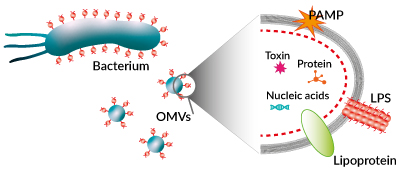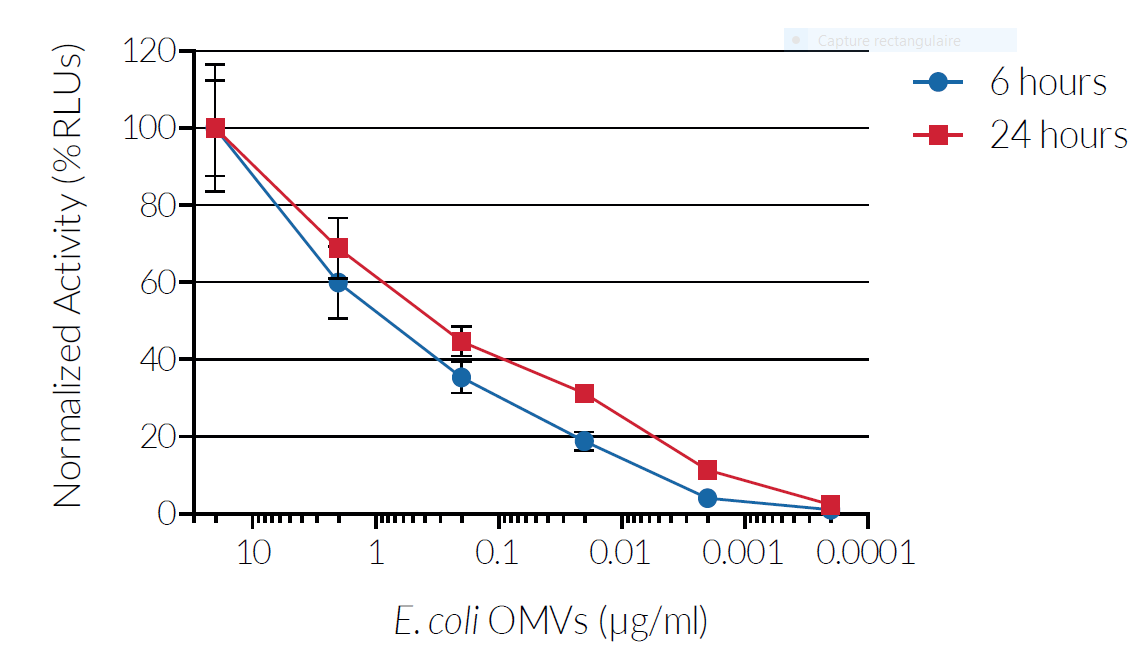E. coli OMVs
| Product | Unit size | Cat. code | Docs. | Qty. | Price | |
|---|---|---|---|---|---|---|
|
E. coli OMVs Escherichia coli outer membrane vesicles (OMVs) |
Show product |
100 µg |
tlrl-omv-1
|
|
||
|
E. coli OMVs InvivoFit™ Escherichia coli outer membrane vesicles (OMVs) for in vivo use |
Show product |
500 µg |
tlrl-omv
|
|

Outer membrane vesicles (OMVs)
E. coli outer membrane vesicles - Caspase 11-4/5 inducers
InvivoGen provides two grades of E. coli outer membrane vesicles (OMVs) to foster your research on the non‑canonical inflammasome response:
— E. coli OMVs (standard preparation) - recommended for in vitro studies
— E. coli OMVs InvivoFit™ - recommended for in vivo studies.
OMVs are small, spherical bodies secreted by gram-negative bacteria. They were recently described as potent caspase 4/5 (caspase 11 in mice) inflammasome inducers [1].
InvivoGen's OMVs have been purified from Escherichia coli BL21 using an optimized procedure, providing lot-to-lot reproducibility. Importantly, activation of the caspase 11-4/5 non-canonical inflammasome is confirmed in vivo and using THP1-HMGB1-Lucia™ cells.
 InvivoGen also offers:
InvivoGen also offers:
• THP1-KO-CASP4 cells: Inflammasome Test Cells
• RAW-ASC KO-CASP11 cells: Inflammasome Test Cells
Key features:
- Inducer of non-canonical caspase 11-4/5 inflammasome pathways in vitro and in vivo
- Can be used in murine or human cellular assays
- Each lot is characterized (size) and functional tested (activation of TLR2 and TLR4).
- InvivoFit™ grade: guaranteed sterile, endotoxin level >105 EU/mg
![]() Read our review on the NLRP3 inflammasome.
Read our review on the NLRP3 inflammasome.
![]() Download our Practical guide on Inflammasomes.
Download our Practical guide on Inflammasomes.
1. Vanaja, S.K. et al., 2016. Bacterial Outer Membrane Vesicles Mediate Cytosolic Localization of LPS and Caspase-11 Activation. Cell 165:1106-1119.
Back to the topSpecifications
E. coli OMVs
Source: Escherichia coli BL21
Specificity: Caspase 11-4/5 inflammasome
Working concentrations: : 0.2 - 100 µg/mL (in vitro) and 10 - 100 µg/mouse (in vivo)
Quality Control:
- Size range: 35-60 nm
- Activation of TLR2 and TLR4 by E. coli OMVs has been confirmed using HEK-Blue™ TLR cellular assays.
- Inflammasome activation by E. coli OMVs has been determined by the induction of pyroptosis in THP1-HMGB1-Lucia™ cells.
E. coli OMVs InvivoFit™
Source: Escherichia coli BL21
Specificity: Caspase 11-4/5 inflammasome
Working concentrations: 0.2 - 100 µg/mL (in vitro) and 10 - 100 µg/mouse (in vivo)
Quality Control:
- Endotoxin levels: >105 EU/mg of OMVs
- E. coli OMVs InvivoFit™ are guaranteed sterile.
- Size range: 35-60 nm
- Activation of TLR2 and TLR4 by E. coli OMVs InvivoFit™ has been confirmed using HEK-Blue™ TLR cellular assays.
- Inflammasome activation by E. coli OMVs InvivoFit™ has been determined by in vivo assays and the induction of pyroptosis in THP1-HMGB1-Lucia™ cells.
Back to the top
Contents
Please note: each ligand is sold separately.
The quantity of protein was measured by a BCA protein assay. Both ligands are provided with 1.5 ml of sterile, endotoxin-free water.
E. coli OMVs
- tlrl-omv-1: 100 µg
E. coli OMVs InvivoFit™
- tlrl-omv: 500 µg
![]() Product is shipped at room temperature
Product is shipped at room temperature
![]() Upon receipt product should be stored at -20°C
Upon receipt product should be stored at -20°C
InvivoFit™
InvivoFit™ is a high-quality standard specifically adapted for in vivo studies. InvivoFit™ products are filter-sterilized (0.2 µm) and filled under strict aseptic conditions in a clean room. The level of bacterial contaminants (endotoxins and lipoproteins) in each lot is verified using a LAL assay and a TLR2 and TLR4 reporter assay.
Back to the topDetails
OMVs are small, non-replicative, immunogenic spherical bodies secreted by both commensal and pathogenic gram-negative bacteria [1]. They contain various pathogen-associated molecular patterns (PAMPs) such as DNA, RNA, peptidoglycan, protein, toxins and lipopolysaccharides (LPS). These PAMPs can induce both pro- and anti-inflammatory responses; a balancing act that can result in either pathogen clearance or bacterial survival [2]. They interact with pattern recognition receptors (PRRs) expressed on the surface of host cells such as Toll-like receptors (TLRs). Additionally, OMVs can be endocytosed and deliver their highly immunogenic cargo directly to the cytosol of the host cell. This triggers the non-canonical caspase 11-4/5 inflammasome in mice and humans, respectively. Ultimately, the activation of this complex results in pyroptotic cell death through the action of gasdermin D (GSDMD) and the release of pro-inflammatory cytokines such as IL-1β and IL-18 [3].
References:
1. Kulp, A. & Kuehn, M.J., 2010. Biological functions and biogenesis of secreted bacterial outer membrane vesicles. Annu Rev Microbiol 64:163-184.
2. Kaparakis-Liaskos, M. & Ferrero, R.L., 2015. Immune modulation by bacterial outer membrane vesicles. Nat Rev Immunol 15:375-387.
3. Vanaja, S.K. et al., 2016. Bacterial Outer Membrane Vesicles Mediate Cytosolic Localization of LPS and Caspase-11 Activation. Cell 165:1106-1119.
Back to the top












